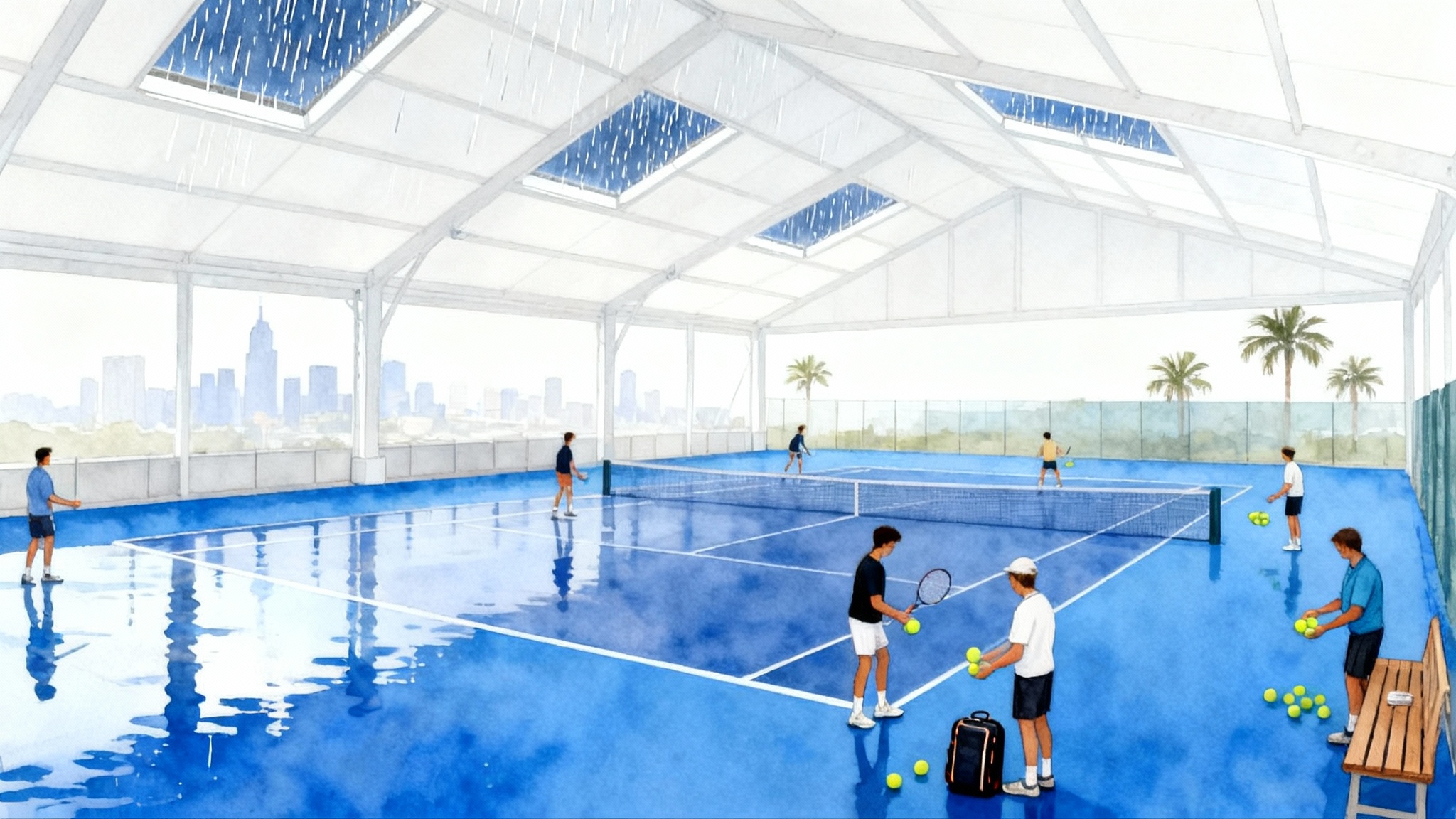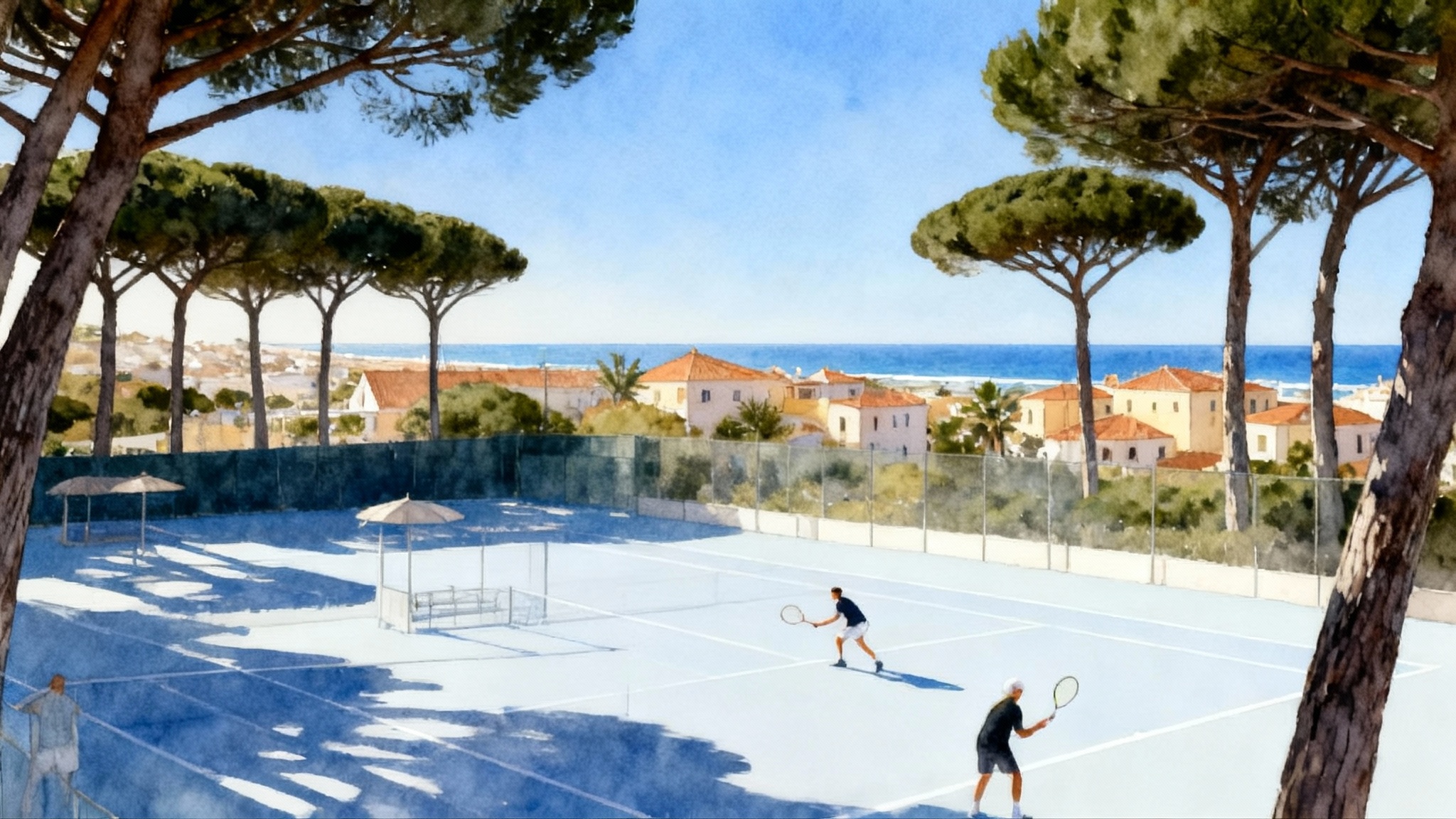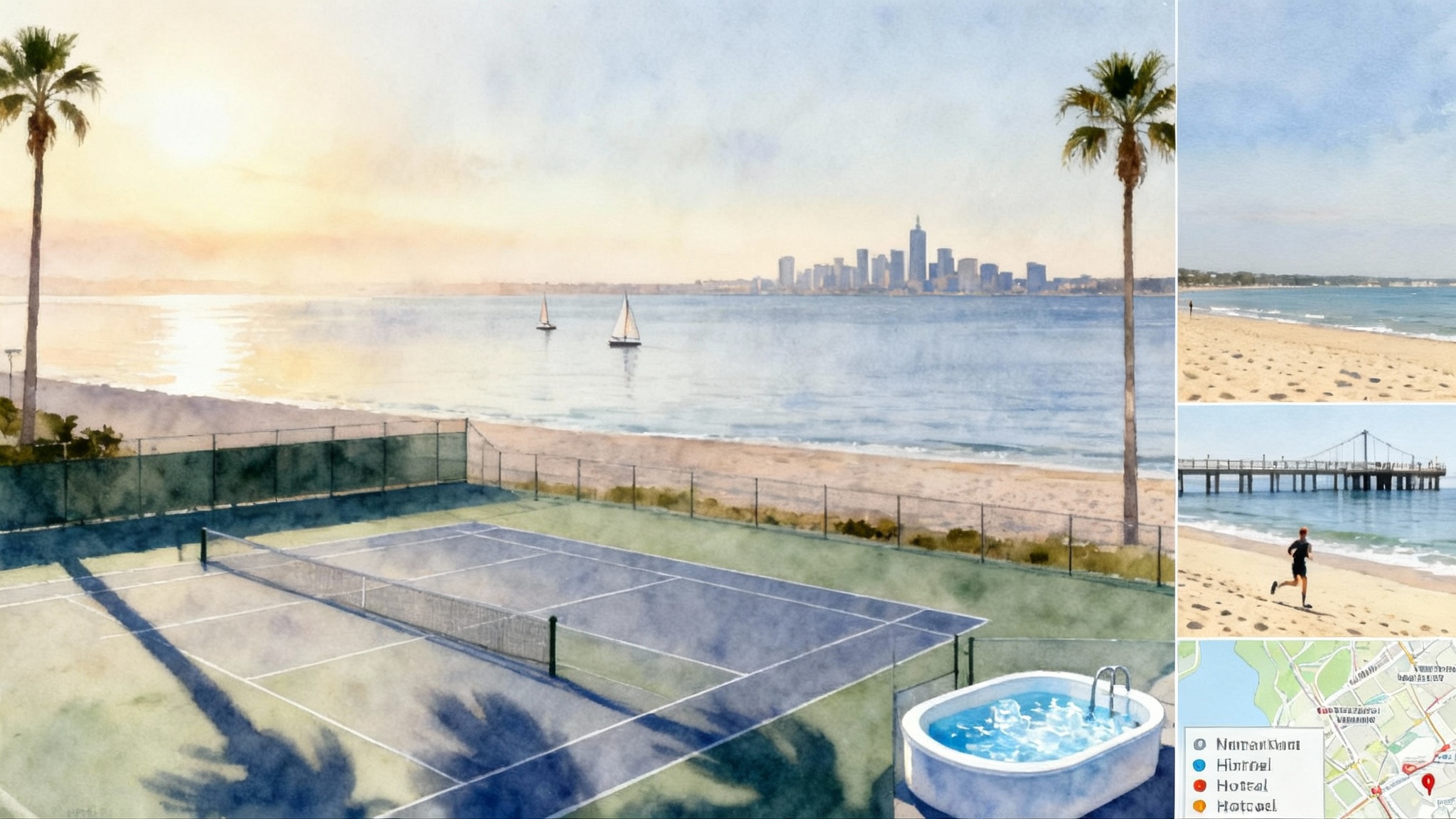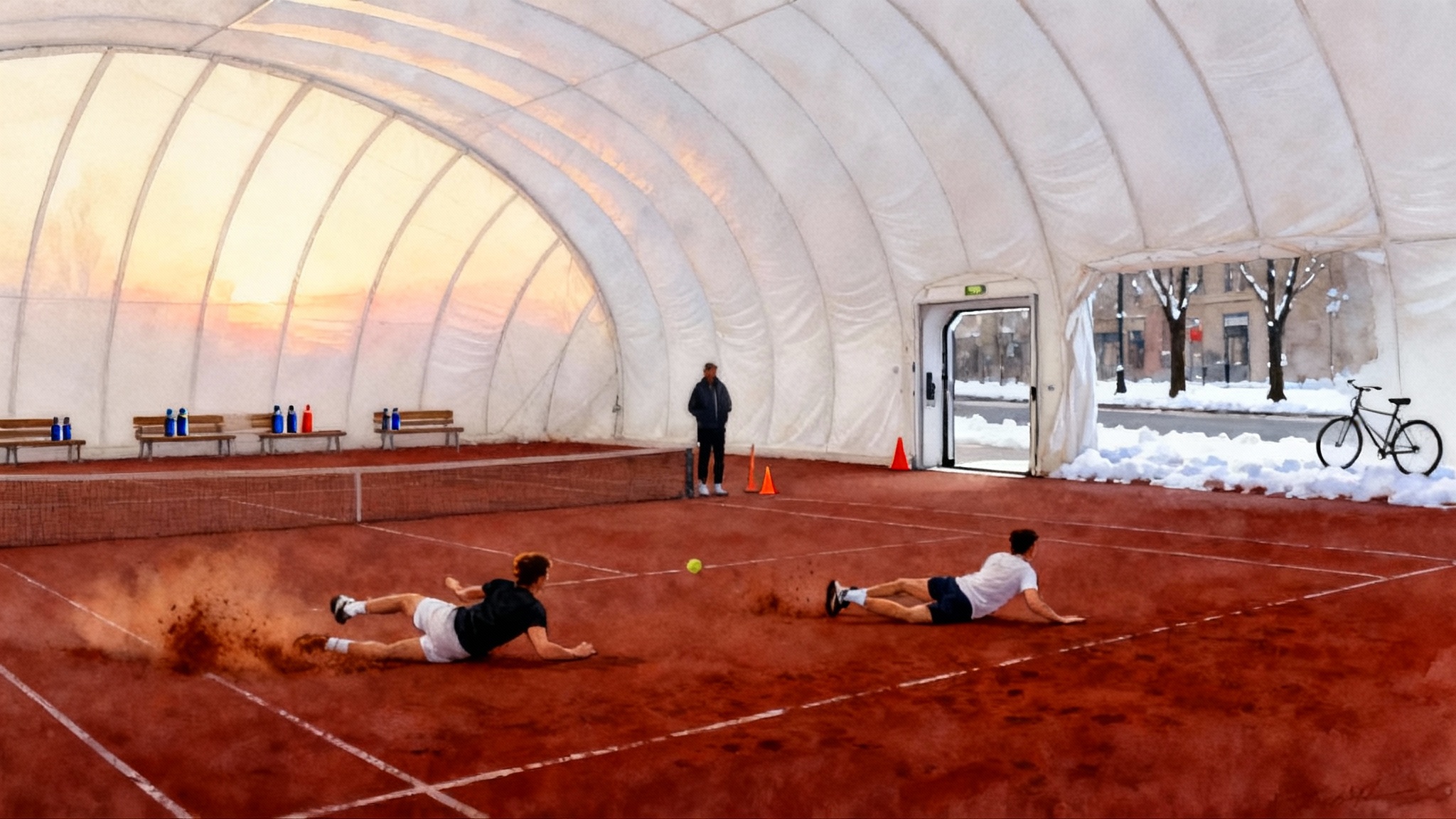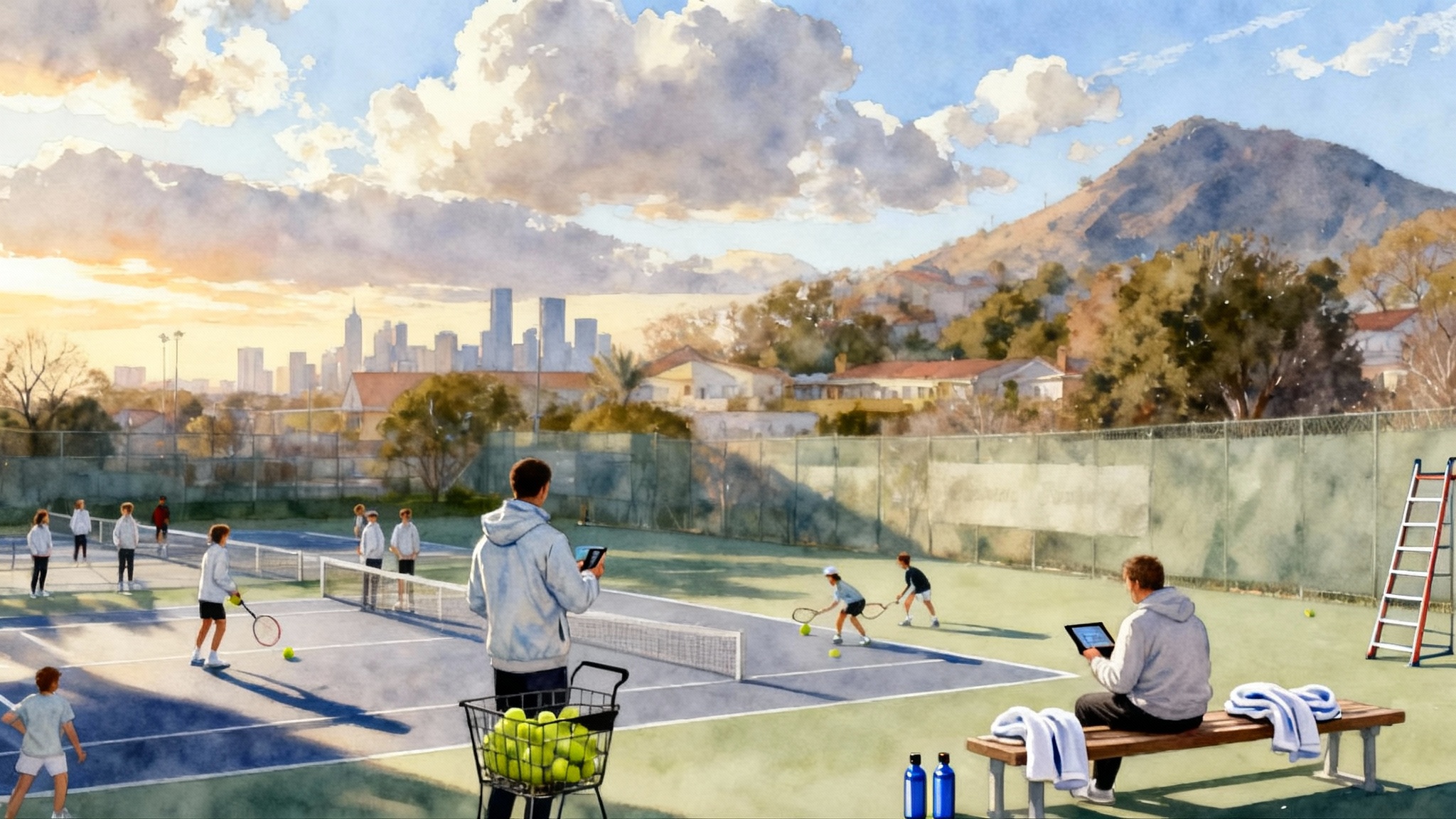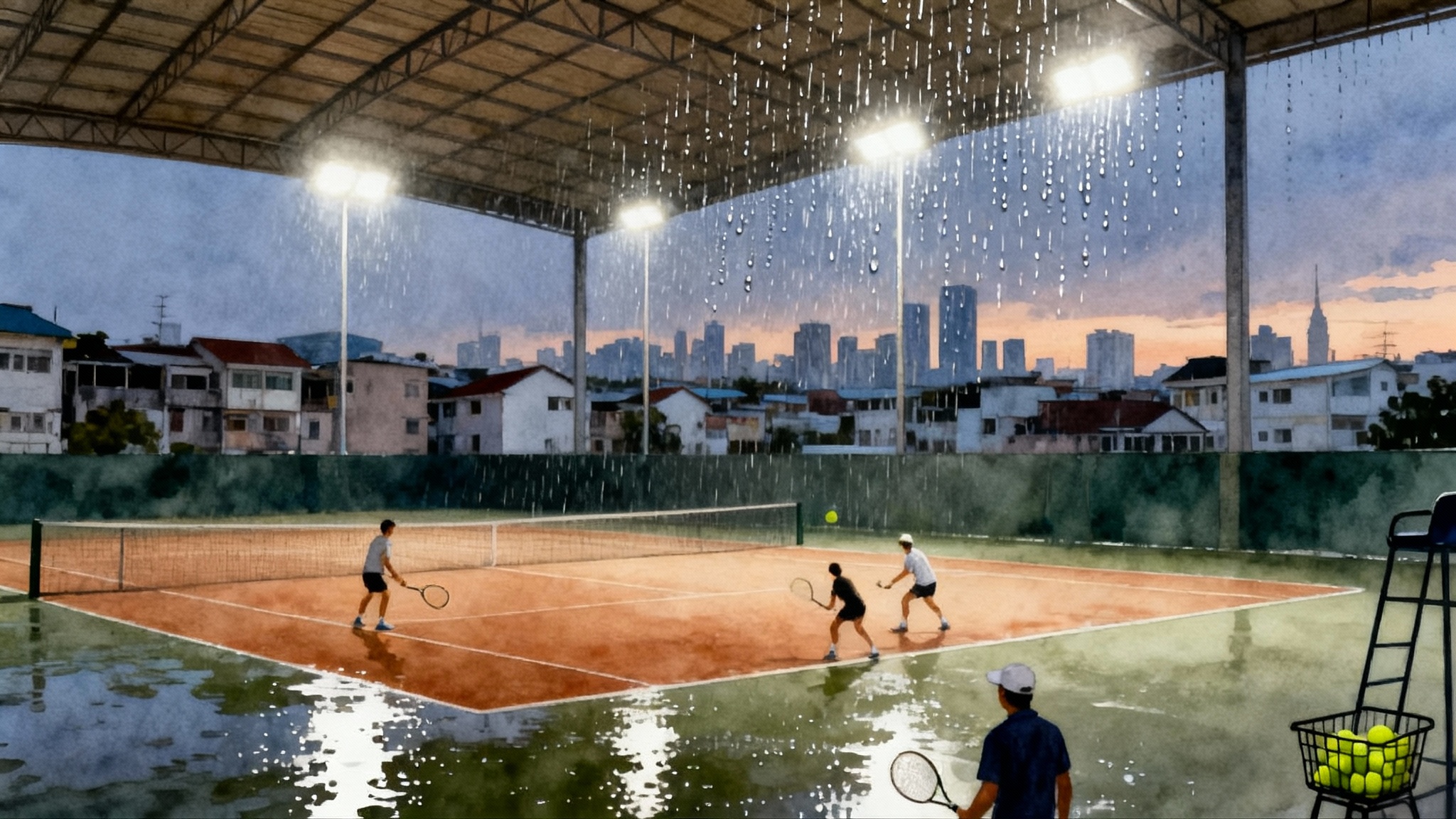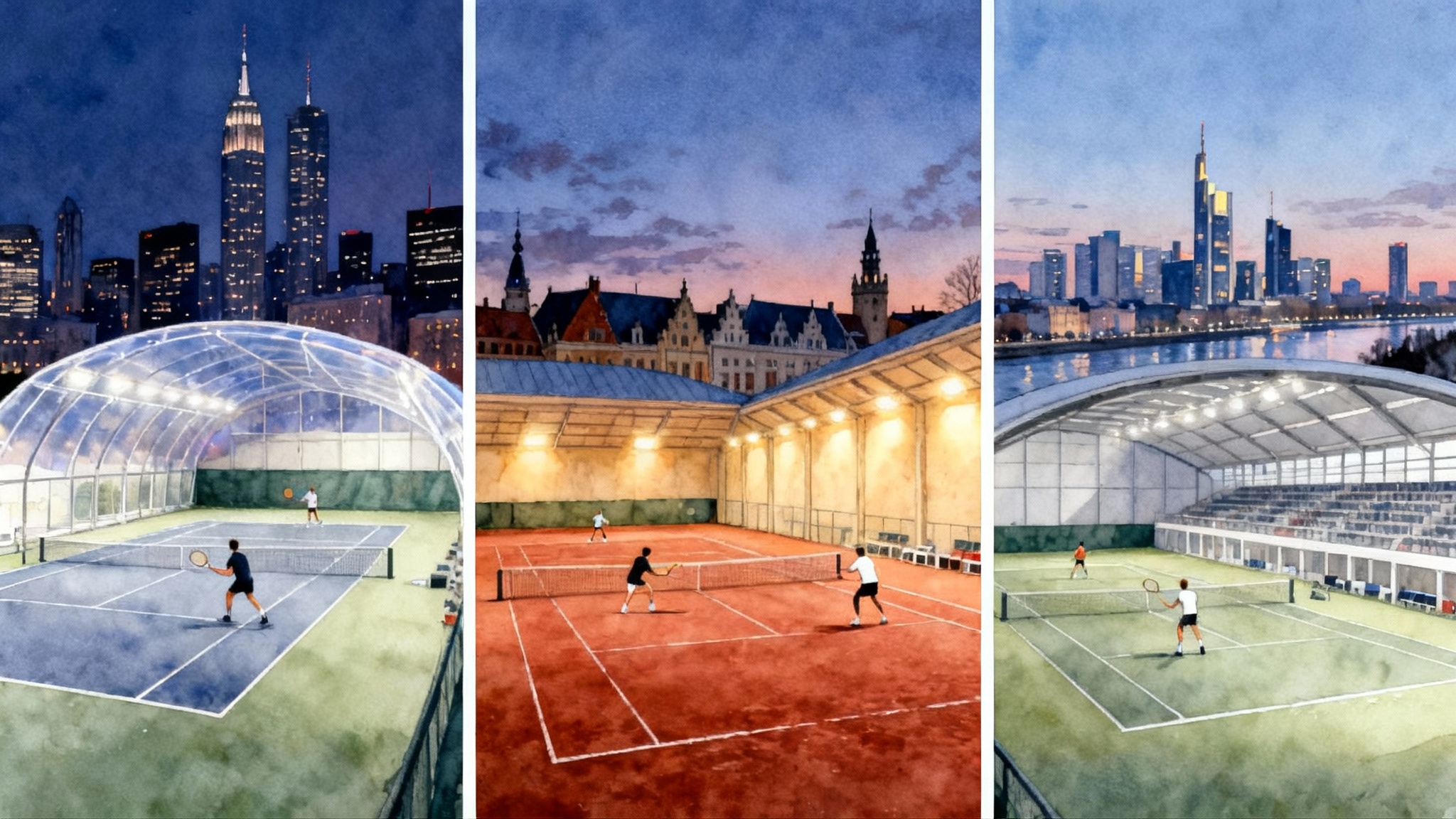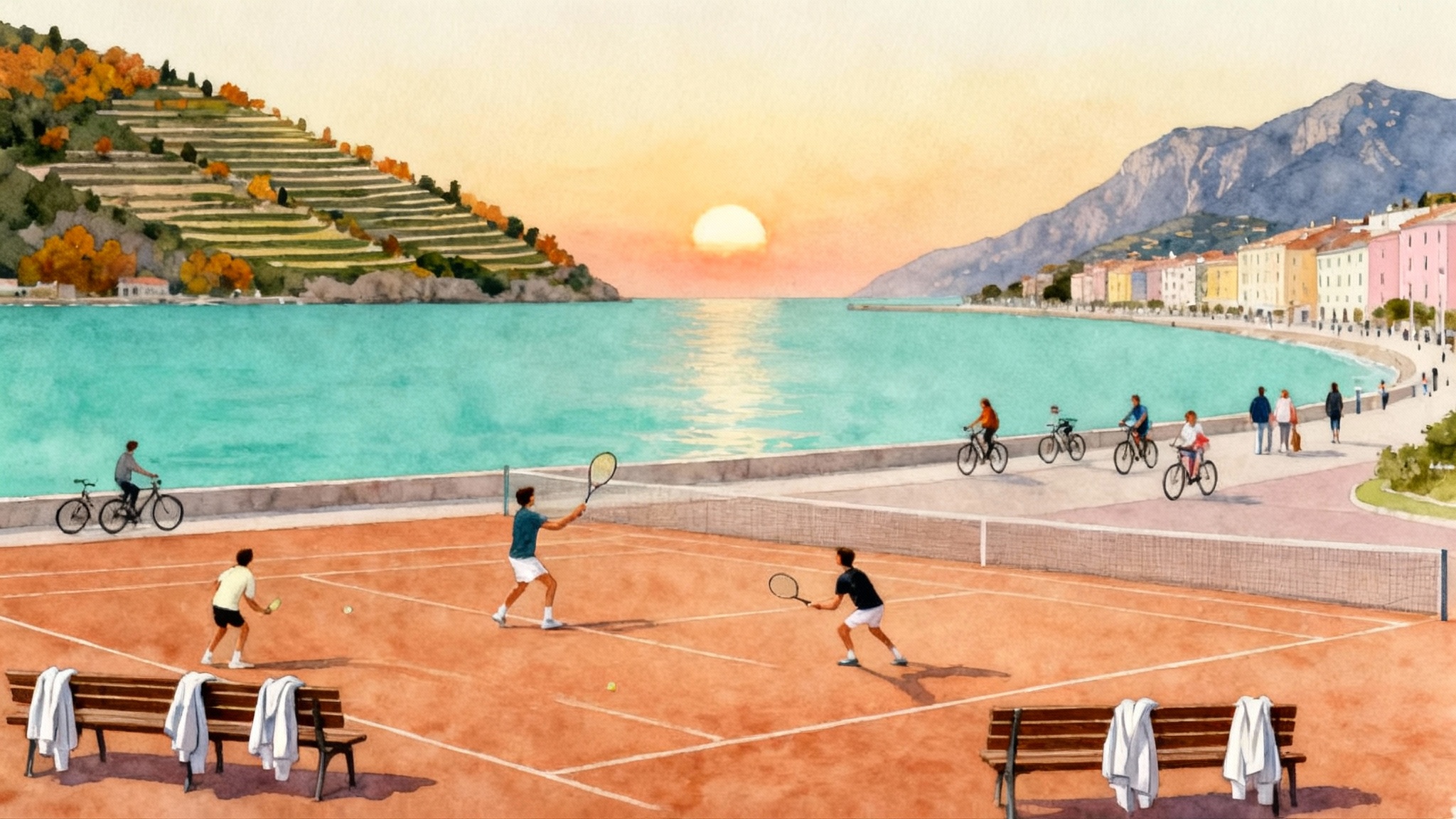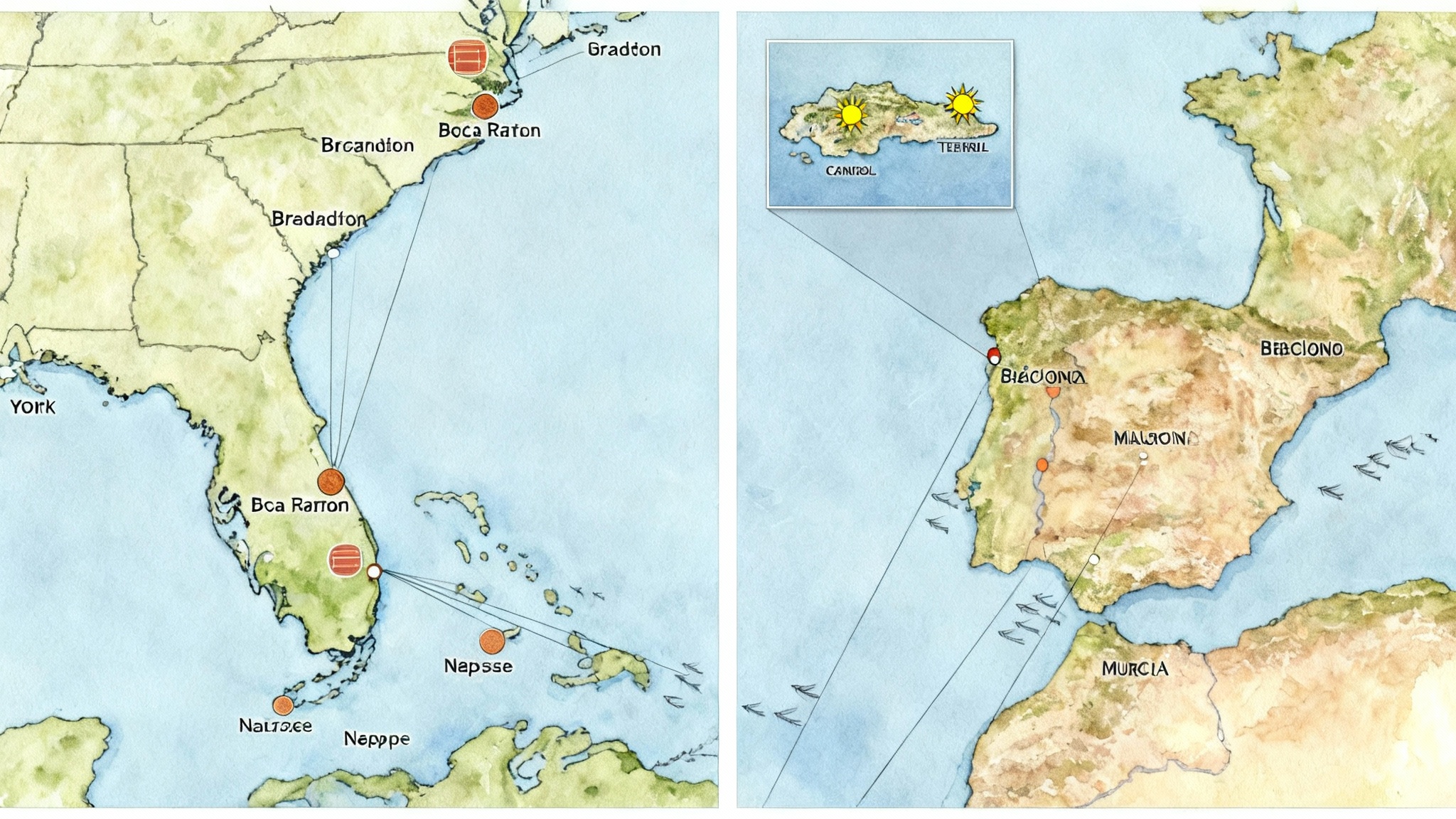Dubai Winter Tennis: October to April Outdoor Training Guide
Plan a reliable winter base in Dubai from October to April. Get monthly weather, court access and costs, indoor backups, visas and flights, Ramadan scheduling, heat tips, a regional tournament map, and sample week budgets.
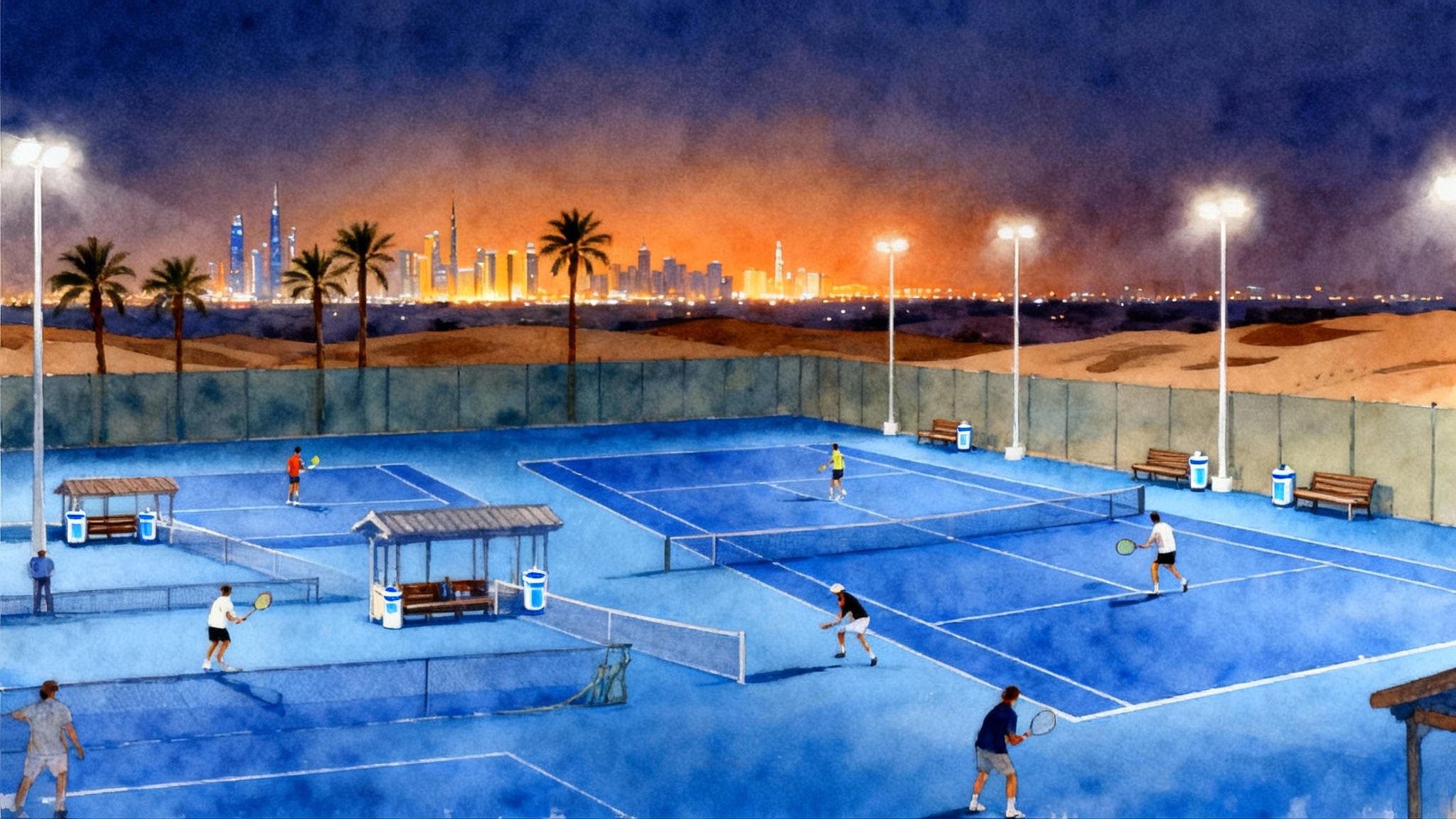
Why Dubai is the most reliable October to April tennis base
If your team wants outdoor hard courts, predictable sunshine, and short flights from Europe, Africa, and South Asia, Dubai is the safest winter bet. The city’s dry climate and infrastructure make it rare to lose a training day between October and April. Courts are plentiful across academies, clubs, hotels, and communities, and most sites run lighting late into the evening, so you can schedule around heat or matchplay blocks.
This guide gives you the practical details coaches and families need to make a season plan: monthly weather, indoor backups, costs and court access, visas and flights, Ramadan scheduling, heat-acclimation tips, a regional tournament map across the Gulf, sample week plans and budgets, and how Emilio Sánchez Academy Dubai fits junior, adult, and college-prep pathways.
Monthly weather: what to expect on court
Dubai’s winter weather trends are consistent year to year. Plan with the ranges below, then fine-tune week by week. Temperatures are air readings in shade; court-level radiant heat adds a few extra degrees in the sun.
- October: Typical highs 32–36 °C (90–97 °F), lows 23–27 °C (73–81 °F). Humidity easing after summer; best play windows are sunrise and after 5 p.m.
- November: Highs 28–32 °C (82–90 °F), lows 19–23 °C (66–73 °F). Comfortable all day with sunscreen and hydration.
- December: Highs 24–28 °C (75–82 °F), lows 16–19 °C (61–66 °F). Prime training weather; rare quick showers.
- January: Highs 22–26 °C (72–79 °F), lows 14–17 °C (57–63 °F). Cool mornings; bring a light layer for warm-up.
- February: Highs 23–27 °C (73–81 °F), lows 15–18 °C (59–64 °F). Slight chance of brief rain; courts dry fast.
- March: Highs 27–31 °C (81–88 °F), lows 18–21 °C (64–70 °F). Shift matches toward late afternoon as sun strengthens.
- April: Highs 31–35 °C (88–95 °F), lows 21–24 °C (70–75 °F). Plan doubles or fitness early, heavier drilling after sunset.
Wind is usually light to moderate. When it does pick up, it is steady enough to train crosswind tactics without constant gusts. Rainfall is scarce and typically short. The practical takeaway: you can schedule outdoor blocks with confidence, reserving lights for flexibility.
Indoor backups and rainy-day planning
Indoor tennis courts are limited in Dubai. Treat this as a planning constraint, not a problem. Build your standby plan around these levers:
- Book lights early. Most clubs and academies accept evening reservations one to two weeks ahead for prime slots.
- Use shaded or semi-covered courts when available. Even partial shade cuts radiant heat on hard courts.
- Keep an off-court day ready. If a rare rain band rolls through, pivot to video, scouting, mobility, or classroom sessions.
- Shift to early starts. Sunrise sessions let you complete two hours before heat builds in October and April.
- Consider hospitality club access. Some hotels sell day passes to guests for courts and pools, which helps with recovery if a session is shortened.
The bottom line: you are unlikely to need a true indoor court. A lights-first schedule and a flexible day plan will absorb most weather hiccups.
Court access, costs, and how to book
Dubai’s tennis ecosystem is a mix of academies, private clubs, hotel courts, and community facilities. Access is straightforward once you pick your base area.
- Academies: Book group programs, matchplay, and private lessons. Court use is normally included when you are in a program; private rentals outside lesson hours may be offered. Expect 300–600 United Arab Emirates dirhams per hour for elite private sessions, less for assistant coaches.
- Clubs and communities: Memberships or pay-per-hour rentals are common. Peak evening rentals on hard courts typically range from 80–250 dirhams per hour, with an added lights fee at some venues.
- Hotels: Many resorts and business hotels have one or two quality hard courts. Guests can often reserve at no charge or a modest fee; non-guests may pay a higher hourly rate or day pass.
Tip for teams: choose accommodation near your primary courts to cut traffic time. Sports City, Jumeirah Village Circle, Dubai Hills, Al Barsha, and parts of Arabian Ranches offer good access to courts and main roads without the congestion of the beachfront.
Stringing and gear: Budget 80–120 dirhams per racquet for same-day restringing, more for premium strings. Grip tape and overgrips are widely available. Bring a backup set of grommets if you are staying longer than two weeks and use textured strings.
Visas, flights, and where to stay
Visas: Many nationalities receive a visa on arrival for short stays, while others apply in advance. Requirements vary by passport and length of stay. Check your specific rules before booking and carry a passport with at least six months validity. Airlines often verify eligibility at check-in.
Flights: Dubai International Airport is one of the best connected hubs. Typical nonstop flight times are about 6–8 hours from Central Europe, 3–4 hours from India, 8–10 hours from Southeast Asia, and 12–14 hours from the East Coast of the United States. Red-eye arrivals land early morning, which is convenient for a light first session after hotel check-in.
Neighborhoods: For training blocks, serviced apartments are practical for laundry and meals. Look for one-bedroom or two-bedroom units near your academy of choice. Weekly rates vary widely but a mid-season range for a good serviced apartment is 2,800–6,000 dirhams per week depending on location and size. Supermarkets and pharmacies are numerous, and food delivery is quick.
Local transport: Ride-hailing is reliable and cost-effective. For teams, a weekly car rental can be economical if you are shuttling players between courts, gym, and tournaments.
Ramadan scheduling made simple
Ramadan shifts by roughly ten to eleven days each year. When your block overlaps Ramadan, expect three practical changes:
- Match and training times move later. Evening and night sessions become more common so players and staff can train after breaking the fast.
- Food and hydration require planning. Hotels and many restaurants serve as normal for non-fasting guests, but players who are fasting should coordinate meal timing closely and adjust training intensity in the late afternoon.
- Noise and etiquette. Keep music low near sundown and be mindful of crowds at iftar time when traffic spikes.
Tournaments and academies typically continue on normal or slightly adjusted schedules. For high school or college teams, the simple tactic is to stack video and scouting in the late afternoon, train after sunset, and use mornings for recovery and light skill work.
Heat acclimation for hard-court blocks
Good heat management protects performance and prevents missed days. A ten-day ramp works well for most players who arrive from cooler climates.
- Day 1–3: One main hit per day, 60–75 minutes at aerobic intensity with frequent shade breaks. Use hat and sunglasses, apply sunscreen every 90 minutes, and weigh in and out to estimate sweat loss. Replace 150 percent of weight lost within two hours post-session.
- Day 4–6: Split sessions, 60 minutes morning technical, 60 minutes evening situational points. Add light on-court intervals at the end of the morning block. Target 500–800 milligrams of sodium per liter of fluid if you are a salty sweater.
- Day 7–10: Normal training volume with intensity spikes. Place heavy live-ball or matchplay at night. Use cold towels, ice in wrist veins during changeovers, and shade every 20 minutes if the sun is high.
Gear checklist for heat: white or light-colored tops, two hats, sunscreen 50+, zinc for nose and cheeks, a soft towel for ice, two insulated bottles, sweatbands, and a small scale for the apartment to monitor hydration.
Regional tournament map: UAE, Bahrain, Oman, Saudi Arabia
One of Dubai’s competitive advantages is the regional calendar. Between October and April, the Gulf often hosts a string of International Tennis Federation junior events and entry-level professional weeks, plus national tournaments.
Common hubs and what to expect:
- United Arab Emirates: Dubai, Abu Dhabi, Fujairah, Al Ain. Frequent junior events and periodic entry-level professional weeks. Travel by car between cities is straightforward.
- Bahrain: Manama. Regular junior weeks and occasional professional events. Short flights from Dubai and easy logistics on arrival.
- Oman: Muscat. Popular with traveling players for week-to-week swings. Direct flights from Dubai take about one hour.
- Saudi Arabia: Riyadh, Jeddah, Dammam. Growing slate of junior and professional events. Flight times from Dubai are roughly 2–3 hours depending on city.
Planning a swing: Build two to four consecutive weeks that minimize border hops. For example, start with a Dubai training week, then two weeks in Oman, and return to the United Arab Emirates for a final event. Intra-Gulf round trips are often cost-effective; budget 400–900 dirhams per person for regional flights depending on dates and baggage.
Entry and transitions: Allow buffer days between events for recovery and light drilling. Book refundable hotel nights for the last two days of any event in case you go deep in the draw.
Sample week plans and budgets
Below are three templates you can adapt. Amounts are in dirhams, with rough United States dollar conversions shown using the long-standing peg where 1 dollar is about 3.67 dirhams.
Junior high-performance week at Emilio Sánchez Academy - Dubai
Objective: Skill consolidation and matchplay; specific patterns, footwork, and point construction.
- Monday to Friday
08:00–09:15: Movement prep and footwork ladders
09:15–11:15: Live-ball drills, pattern work, serve plus one, return plus one
17:30–19:00: Conditioned points and sets
19:00–19:30: Recovery, mobility, decompression - Saturday
09:00–11:00: Matchplay day with format rotations
Afternoon: Team activity or scouting video - Sunday
Rest or optional 60-minute technical tune-up
Estimated budget per player for 7 days
- Academy group program: 1,800–2,600 dirhams (490–710 dollars)
- Two private lessons added: 600–1,200 dirhams (160–330 dollars)
- Stringing two frames: 160–240 dirhams (45–65 dollars)
- Accommodation in serviced apartment: 2,500–4,500 dirhams (680–1,225 dollars)
- Meals and groceries: 700–1,000 dirhams (190–270 dollars)
- Local transport: 300–600 dirhams (80–165 dollars)
Total: 6,060–9,940 dirhams per player for the week, not including flights.
Adult performance tune-up week
Objective: Raise hitting pace safely, sharpen serve and return, improve doubles patterns.
- Monday to Friday
07:00–08:00: Mobility and shoulder care
08:00–09:30: Technical rebuild sequences and basket work
18:30–20:00: Doubles and return games under lights - Saturday
09:00–10:30: Match or coached point play - Sunday
Rest, spa, or light hit
Estimated budget for a single adult
- Clinics and two privates: 1,200–2,000 dirhams (325–545 dollars)
- Court rentals for self-hits: 400–800 dirhams (110–220 dollars)
- Accommodation: 2,800–5,000 dirhams (760–1,360 dollars)
- Meals: 900–1,200 dirhams (245–325 dollars)
- Transport: 300–600 dirhams (80–165 dollars)
Total: 5,600–9,600 dirhams for the week, excluding flights.
College-prep pathway week
Objective: Simulate college density, capture video, and collect match data for coach outreach.
- Monday to Friday
07:30–08:15: Mobility and injury-prevention circuit
08:15–10:15: Live ball with patterns and pressure drills
16:00–17:00: Strength, speed, and change of direction
18:30–20:30: Matchplay sets under lights; video capture on tripod baseline - Saturday
10:00–12:00: Tournament-style match with officiating practice - Sunday
Edit video highlights and update academic-athletic profile
Estimated budget per player
- Academy group and performance add-ons: 2,200–3,200 dirhams (600–870 dollars)
- Two private sessions for serve and return: 600–1,200 dirhams (160–330 dollars)
- Video editing support if outsourced: 300–600 dirhams (80–165 dollars)
- Accommodation: 2,800–5,000 dirhams (760–1,360 dollars)
- Meals: 800–1,100 dirhams (220–300 dollars)
- Transport: 300–600 dirhams (80–165 dollars)
Total: 7,000–11,700 dirhams for the week, excluding flights.
How Emilio Sánchez Academy - Dubai fits every pathway
The Dubai campus of Emilio Sánchez Academy brings the Spanish high-performance model to the Gulf on outdoor hard courts, with a simple structure that serves three audiences:
- Juniors: Group training blocks that emphasize footwork, point construction, and competitive sets. Weekly matchplay makes it easy to link training to weekend tournaments. Coaches use clear session goals and repeatable routines so players know exactly what success looks like each day.
- Adults: Performance-focused clinics and private sessions that protect the shoulder and elbow while increasing hitting tempo. Expect precise basket progressions for serve and return and situational games that translate to doubles success.
- College-prep: A week format that mirrors the training density of a college team. Players can collect match footage, refine a recruiting video, and build a calendar that pairs Dubai training weeks with regional events. Staff can advise on Universal Tennis Rating strategy, travel loads, and academic timing.
What stands out is the academy’s sequencing. Sessions start with movement quality, progress to pattern work, and end with pressure scoring, which helps juniors and adults alike convert practice pace into match poise. For families, the clear weekly rhythm and proximity to airports make back-to-back weeks simple to book across a school break.
Packing list and practical tips
- Hard-court shoes with fresh tread and a backup pair
- Two hats, a light long-sleeve top for sun, and sunglasses
- Sunscreen 50+, zinc for nose and cheeks, and a small aloe gel
- Overgrips and one spare set of strings you already trust
- Insulated bottles, electrolyte tabs or mix, and a compact scale
- A light jump rope and minibands for warm-ups in small spaces
- Tripod or fence clip for match video
Money and payments: Cards are widely accepted. Keep a small amount of cash for taxis, tips, and stringing if the shop prefers cash. Mobile payment apps are common.
Medical and recovery: Book a sports massage midweek if training loads are high. Most neighborhoods have clinics with physiotherapists who know tennis movement patterns.
Putting it all together
- If you want the coolest weather, aim for December to February and schedule sessions throughout the day.
- If you want combined training and beach time, aim for November or March with a lights-first schedule. For a Southern Europe alternative, compare Dubai with the Algarve winter outdoor guide.
- If you need a heat-toughness block before spring events, target late October or April with early and late hits.
- Build a two to four week arc by adding a regional event swing in Oman, Bahrain, or within the United Arab Emirates.
- Use Emilio Sánchez Academy Dubai as the anchor. Juniors get repetition and matchplay; adults get efficient, shoulder-safe tempo; college-prep athletes get density, data, and footage.
- For a macro view of winter choices across Florida, Spain, and the Canaries, check the Winter 2025 training map.
Conclusion
Dubai rewards planners. The weather cooperates, the courts are ready, and the logistics are smooth. Choose your month with intent, stack your sessions under lights when you need to, and keep your hydration and recovery simple and consistent. With a clear week plan and an academy base that understands juniors, adults, and college-prep demands, you can turn October to April into your most productive outdoor hard-court season of the year.
